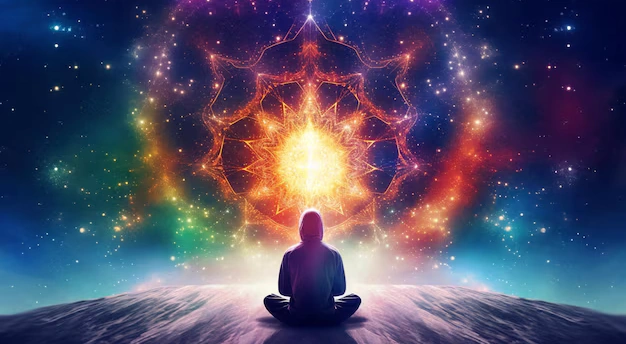
“The real question is not whether life exists after death. The real question is whether you are alive before death.” – Osho
The Great Spiritual Counterfeit
We live in an unprecedented era of spiritual abundance—and spiritual poverty. Never before have so many practices, teachings, and traditions been so readily available, yet never before has authentic spiritual transformation seemed so elusive. The modern spiritual landscape resembles a vast bazaar where enlightenment is sold by the subscription, where ancient wisdom is repackaged as lifestyle optimization, and where the profound mystery of existence is reduced to hashtag-friendly platitudes.
This is not another article celebrating the democratization of spirituality or the innovative fusion of technology with ancient practices. This is an examination of what we have lost in our rush to make the sacred accessible, marketable, and convenient.
The Commodification of the Sacred
The most insidious development in contemporary spirituality is not the rise of false teachers—charlatans have existed throughout history. Rather, it is the systematic transformation of spiritual practice into consumer goods. Meditation becomes a productivity hack. Ancient mantras become branded affirmations. The dark night of the soul becomes a “healing journey” with predetermined outcomes and Instagram-worthy revelations.
This commodification operates on multiple levels:
The Comfort Trap: Modern spirituality often promises transformation without genuine sacrifice, growth without genuine challenge. We are sold the fantasy that awakening should feel good, that authentic practice should always bring peace and clarity. This fundamental misunderstanding prevents real spiritual work from even beginning.
The Experience Economy: Spiritual seeking becomes a collection of peak experiences—ayahuasca ceremonies, meditation retreats, energy healings—rather than the patient, often unglamorous work of fundamental transformation. We mistake altered states for altered traits, confusing temporary transcendence with permanent change.
The Identity Marketplace: Spirituality becomes another form of identity construction. We become “the spiritual one” in our social circles, collecting practices and philosophies like cultural capital, using spiritual language to signal our sophistication while remaining fundamentally unchanged.
The Technology Paradox: Connection and Fragmentation
Digital technology presents spirituality with its greatest paradox: unprecedented access to wisdom traditions coinciding with unprecedented fragmentation of attention and presence. While meditation apps guide millions through mindfulness practices, the very devices delivering these practices systematically erode our capacity for the sustained attention that genuine contemplative work requires.
The deeper issue is not merely distraction but the rewiring of consciousness itself. Digital technology operates on principles fundamentally opposed to contemplative development:
- Immediacy vs. Patience: Spiritual growth requires what mystics have always called “holy patience”—the willingness to remain present with difficulty, uncertainty, and the slow pace of genuine transformation. Digital technology conditions us for immediate gratification and constant stimulation.
- Surface vs. Depth: Genuine spiritual practice involves diving beneath the surface mind into deeper layers of consciousness. Social media and digital communication keep us perpetually at the surface, skimming across information without penetrating to wisdom.
- Presence vs. Performance: Authentic spirituality requires radical honesty about our actual experience, including its mundane and uncomfortable aspects. Social media spirituality becomes performance, curating enlightened personas while avoiding real encounter with our shadow material.
The Lost Art of Spiritual Discernment
Perhaps the most critical skill missing from contemporary spiritual culture is discernment—the ability to distinguish between authentic spiritual phenomena and their counterfeits. Traditional spiritual cultures developed sophisticated methods for evaluating spiritual claims and experiences. These safeguards have been largely abandoned in favor of a democratic spirituality where every experience is equally valid and every teacher equally authentic.
Real discernment requires:
Intellectual Rigor: Authentic spiritual traditions have always engaged the full range of human intelligence, not just emotional or intuitive faculties. The anti-intellectual bias in much contemporary spirituality leaves practitioners vulnerable to manipulation and self-deception.
Psychological Sophistication: Understanding the difference between spiritual insight and psychological projection, between mystical experience and mental inflation, between genuine humility and spiritual bypassing.
Cultural Literacy: Recognizing when ancient teachings are being distorted, when practices are being stripped of their essential context, when universal principles are being reduced to personal preferences.
The Ecology of Authentic Practice
Genuine spiritual development requires what we might call an “ecology of practice”—a carefully constructed environment that supports real transformation rather than spiritual entertainment. This ecology has several essential elements:
Sustained Commitment Over Novelty
Authentic spiritual work requires what the Sufis call “polishing the mirror of the heart”—patient, repetitive work that gradually removes the layers of conditioning that obscure our true nature. This process cannot be rushed, optimized, or made more convenient. It requires the kind of sustained commitment that runs counter to our culture’s addiction to novelty and rapid results.
Relationship with Reality, Not Concepts About Reality
Much contemporary spirituality operates at the level of concepts, ideas, and beliefs about awakening rather than direct engagement with the reality of our moment-to-moment experience. Authentic practice requires learning to relate directly to what is actually happening in our bodies, emotions, and minds, rather than to our theories about what should be happening.
Embrace of Difficulty and Paradox
Real spiritual work involves what Pema Chödrön calls “making friends with our fundamental ambiguity.” This means developing the capacity to remain present with uncertainty, contradiction, and the uncomfortable aspects of human existence rather than using spiritual practice to escape into premature transcendence or false unity.
Ethical Foundation
Authentic spirituality has always been inseparable from ethical development. The current trend toward “non-dual” teachings that bypass ethical considerations or reduce morality to personal preference represents a fundamental misunderstanding of how consciousness actually develops.
The Forgotten Dimensions
Several crucial dimensions of spiritual development have been largely forgotten or marginized in contemporary spiritual culture:
The Apophatic Path
Most popular spirituality focuses on what can be known, experienced, or achieved. The apophatic tradition—the way of unknowing—recognizes that the deepest spiritual truths cannot be grasped by the ordinary mind and must be approached through systematic unknowing, through releasing our need to understand and control spiritual experience.
Sacred Ordinariness
Authentic awakening often manifests not as exotic experiences but as a profound transformation in our relationship to ordinary experience. The sacred is found not by escaping the mundane but by penetrating more deeply into the mystery that ordinary experience actually represents.
Impersonal Love
Contemporary spirituality often confuses personal emotional states with spiritual realization. True spiritual development involves discovering forms of love and compassion that transcend personal preferences and emotional attachments—what mystics have called “impersonal love” or “universal compassion.”
The Way Forward: Principles for Authentic Practice
For those genuinely interested in authentic spiritual development rather than spiritual entertainment, several principles can guide the way:
Choose Depth Over Breadth: Rather than sampling numerous traditions and practices, commit deeply to one authentic path. Allow yourself to be challenged and changed by sustained engagement rather than protecting yourself through spiritual tourism.
Embrace Boredom and Difficulty: Real spiritual work often involves long periods of apparent stagnation, uncomfortable psychological material, and the kind of ordinariness that the ego finds deeply threatening. Learn to recognize these as signs of authentic practice rather than problems to be solved.
Seek Qualified Guidance: Find teachers who have demonstrable depth in their tradition, who live what they teach, and who are more interested in your genuine development than in your admiration or financial support.
Integrate Psychological Work: Authentic spiritual development requires honest engagement with psychological patterns, defense mechanisms, and unconscious material. Spiritual practice that bypasses psychological work often leads to spiritual inflation rather than genuine awakening.
Maintain Intellectual Honesty: Continue to think clearly about spiritual claims and experiences. Mysticism has always been compatible with intellectual rigor—indeed, it requires it.
The Ultimate Question
The question facing anyone interested in authentic spiritual development is not “What practice should I do?” or “Which tradition is best?” but rather: “Am I willing to be fundamentally changed by this work, or am I seeking spiritual experiences that confirm my existing sense of self?”
This willingness to be changed—to allow the process of spiritual development to dissolve the very identity that began the search—represents the essential prerequisite for authentic spiritual work. Everything else is spiritual entertainment, however sophisticated its packaging.
The sacred fire that has always been at the heart of genuine spiritual traditions still burns. It has not been extinguished by commercialization, diluted by democratization, or replaced by technological innovation. But accessing this fire requires the same thing it has always required: the courage to move beyond spiritual comfort food toward the kind of practice that genuinely transforms rather than merely decorates our existing sense of self.
In an age of infinite spiritual options, the most radical act may be to choose one authentic path and follow it with the kind of commitment that our ancestors understood was necessary for real spiritual transformation. The fire is still burning. The question is whether we are willing to be consumed by it.
“The spiritual path is not a matter of becoming something other than what you are, but of unbecoming everything that you are not.” – Anonymous Sufi Teaching
CAN YOU IDENTIFY A FALSE SPIRITUAL PROPHET?
A fake spiritual prophet is someone who pretends to have divine insights and contacts, while actually just using their followers to achieve personal benefits. These false prophets take advantage of people’s vulnerabilities by using persuasive words and charm to gain their trust. Their real intentions are not spiritual growth; they are all about selfish and pragmatic goals.
Read the following statements and choose those that best represent your way of thinking.
Count the total number of selected boxes and read the corresponding profile.
0-1: You are immunized against false prophets
2-3: You are not totally immune to false prophets
4-5: You are easily captivated by false prophets
6: You are ideal prey for false prophets
📚 Academic Bibliography
🔮 Spiritual Materialism and Ego Studies
Trungpa, Chögyam. Cutting Through Spiritual Materialism. Shambhala Publications, 2002.
Welwood, John. Toward a Psychology of Awakening: Buddhism, Psychotherapy, and the Path of Personal and Spiritual Transformation. Shambhala Publications, 2000.
Almaas, A.H. The Point of Existence: Transformations of Narcissism in Self-Realization. Shambhala Publications, 1996.
Masters, Robert Augustus. Spiritual Bypassing: When Spirituality Disconnects Us from What Really Matters. North Atlantic Books, 2010.
📖 Non-Dual Philosophy and Consciousness Studies
Nisargadatta Maharaj. I Am That: Talks with Sri Nisargadatta Maharaj. Translated by Maurice Frydman. Acorn Press, 1973.
Krishnamurti, Jiddu. The First and Last Freedom. HarperOne, 1975.
Klein, Jean. I Am. Third Millennium Publications, 1989.
Spira, Rupert. The Nature of Consciousness: Essays on the Unity of Mind and Matter. Sahaja Publications, 2017.
Ramana Maharshi. The Collected Works of Ramana Maharshi. Edited by Arthur Osborne. Rider & Company, 1979.
Adyashanti. The End of Your World: Uncensored Straight Talk on the Nature of Enlightenment. Sounds True, 2008.
🎭 Critical Analysis of Contemporary Spirituality
Carrette, Jeremy, and Richard King. Selling Spirituality: The Silent Takeover of Religion. Routledge, 2005.
Lynch, Gordon. The New Spirituality: An Introduction to Progressive Belief in the Twenty-first Century. I.B. Tauris, 2007.
Heelas, Paul. Spiritualities of Life: New Age Romanticism and Consumptive Capitalism. Blackwell Publishing, 2008.
Partridge, Christopher. The Re-enchantment of the West: Alternative Spiritualities, Sacralization, Popular Culture, and Occulture. T&T Clark International, 2004.
Bruce, Steve. God is Dead: Secularization in the West. Blackwell Publishers, 2002.
🧠 Psychology of Spiritual Seeking and Self-Deception
Becker, Ernest. The Denial of Death. Free Press, 1973.
Yalom, Irvin. Existential Psychotherapy. Basic Books, 1980.
Kegan, Robert. The Evolving Self: Problem and Process in Human Development. Harvard University Press, 1982.
Wilber, Ken. No Boundary: Eastern and Western Approaches to Personal Growth. Shambhala Publications, 2001.
Engler, John. “Therapeutic Aims in Psychotherapy and Meditation: Developmental Stages in the Representation of Self.” Journal of Transpersonal Psychology, vol. 16, no. 1, 1984, pp. 25-61.
📱 Technology and Digital Spirituality Critique
Turkle, Sherry. Alone Together: Why We Expect More from Technology and Less from Each Other. Basic Books, 2011.
Postman, Neil. Technopoly: The Surrender of Culture to Technology. Vintage Books, 1993.
Winner, Langdon. The Whale and the Reactor: A Search for Limits in an Age of High Technology. University of Chicago Press, 1986.
Campbell, Heidi A. Digital Religion: Understanding Religious Practice in New Media Worlds. Routledge, 2012.
Brasher, Brenda E. Give Me That Online Religion. Jossey-Bass, 2001.
🌍 Critique of Ecological and Social Justice Spirituality
White, Lynn Jr. “The Historical Roots of Our Ecological Crisis.” Science, vol. 155, no. 3767, 1967, pp. 1203-1207.
Nash, Roderick Frazier. The Rights of Nature: A History of Environmental Ethics. University of Wisconsin Press, 1989.
Berry, Thomas. The Dream of the Earth. Sierra Club Books, 1988.
Fox, Matthew. Original Blessing: A Primer in Creation Spirituality. Bear & Company, 1988.
Gottlieb, Roger S. A Spirituality of Resistance: Finding a Peaceful Heart and Protecting the Earth. Crossroad Publishing, 1999.
🔍 Spiritual Authority and Teacher-Student Dynamics
Kornfield, Jack. A Path with Heart: A Guide Through the Perils and Promises of Spiritual Life. Bantam Books, 1993.
Zweig, Connie, and Jeremiah Abrams, editors. Meeting the Shadow: The Hidden Power of the Dark Side of Human Nature. Tarcher, 1991.
Kramer, Joel, and Diana Alstad. The Guru Papers: Masks of Authoritarian Power. North Atlantic Books, 1993.
Storr, Anthony. Feet of Clay: Saints, Sinners, and Madmen: A Study of Gurus. Free Press, 1996.
Butler, Katy. “Encountering the Shadow in Buddhist America.” Common Boundary, vol. 8, no. 3, 1990, pp. 14-22.
🎯 Classical Mystical and Philosophical Sources
St. John of the Cross. Dark Night of the Soul. Translated by E. Allison Peers. Dover Publications, 2003. [Originally written c. 1579-1585]
Meister Eckhart. The Essential Sermons, Commentaries, Treatises, and Defense. Translated by Edmund Colledge. Paulist Press, 1981.
Plotinus. The Enneads. Translated by Stephen MacKenna. Penguin Classics, 1991.
Nagarjuna. The Fundamental Wisdom of the Middle Way. Translated by Jay L. Garfield. Oxford University Press, 1995.
Shankara. The Crest-Jewel of Discrimination (Viveka-Chudamani). Translated by Swami Prabhavananda. Vedanta Press, 1978.
📊 Sociological Studies of Contemporary Religion
Berger, Peter L. The Sacred Canopy: Elements of a Sociological Theory of Religion. Anchor Books, 1990.
Roof, Wade Clark. Spiritual Marketplace: Baby Boomers and the Remaking of American Religion. Princeton University Press, 1999.
Wuthnow, Robert. After Heaven: Spirituality in America Since the 1950s. University of California Press, 1998.
Ammerman, Nancy T. “Spiritual But Not Religious? Beyond Binary Choices in the Study of Religion.” Journal for the Scientific Study of Religion, vol. 52, no. 2, 2013, pp. 258-278.
McGuire, Meredith B. Lived Religion: Faith and Practice in Everyday Life. Oxford University Press, 2008.
🧪 Consciousness Research and Neuroscience
Austin, James H. Zen and the Brain: Toward an Understanding of Meditation and Consciousness. MIT Press, 1998.
Newberg, Andrew, and Mark Robert Waldman. How God Changes Your Brain: Breakthrough Findings from a Leading Neuroscientist. Ballantine Books, 2009.
Thompson, Evan. Waking, Dreaming, Being: Self and Consciousness in Neuroscience, Meditation, and Philosophy. Columbia University Press, 2015.
Chalmers, David. The Conscious Mind: In Search of a Fundamental Theory. Oxford University Press, 1996.
Wallace, B. Alan. Contemplative Science: Where Buddhism and Neuroscience Converge. Columbia University Press, 2007.
🛠️ Methodological Notes
Theoretical Framework: This analysis employs critical spiritual philosophy, phenomenological investigation, and sociological critique to examine the paradoxes and contradictions inherent in contemporary spiritual culture.
Source Evaluation: Primary emphasis on classical mystical texts, contemporary non-dual teachings, critical spiritual scholarship, and empirical studies of religious behavior and belief.
Cultural Context: The analysis situates contemporary spirituality within late-stage capitalist consumer culture, examining how market forces and technological mediation transform traditional spiritual practices.
Philosophical Approach: Drawing from existential philosophy, critical theory, and classical mysticism to distinguish authentic spiritual inquiry from its commercial and psychological simulacra.





